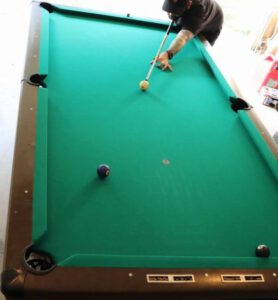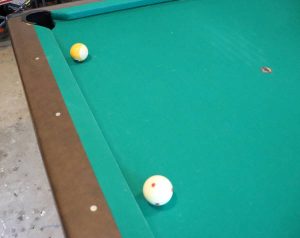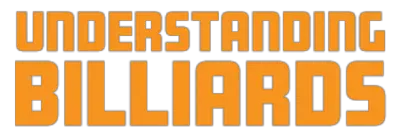Do you struggle with what seems to be the easiest shots in pool, the straight shots? They can be so aggravating; you get yourself lined up perfect for the shot and then you end up missing. Well, let me address the common pitfalls that cause you to miss straight shots so you can avoid doing them in the future.
There are several reasons why you keep missing straights shots and they all boil down to 3 main causes. These 3 causes are improper contact position on the cue ball or object ball, shooting too quickly and rushing your shot, and hitting the ball way too hard. By avoiding these common mistakes, you will improve your pocketing skills and will quit missing those “easy” straight shots.
Now that you know the common mistakes that can cause you to miss a straight-in shot, lets break these down into more detail as well as give you some tips and practice drills to overcome the straight shot.

Improper Contact Position on the Cue Ball or Object Ball
By far the most common reason for missing a straight shot is by hitting the cue ball in the wrong spot or hitting the object ball in the wrong spot. There are many factors to consider when determining why it is happening such as proper stance and stroke fundamentals, unnecessary body movement, or simply underestimating the shot difficulty.
Poor stance and stroke fundamentals can cause the tip of the cue to drift during the stroke and can cause you to miss the intended contact point. This can cause the cue ball to miss the intended target on the object ball. It could also apply unwanted English or spin on the cue ball which will affect the path the cue ball will travel, as well as the throw on the object ball since spin is transferred during the contact.
Something to keep in mind is the distance that the cue ball must travel to contact the object ball. The greater the distance, the more difficult the shot becomes. Any unwanted spin on the cue ball will have more time to react which can cause a greater drift off the intended shooting line.
For example, when you put left spin on the ball, the cue ball is thrown initially off the shooting line to the right because of the deflection from the cue going off the left side of the cue ball. But because of the left spin on the cue ball it will veer back onto the shooting line before contacting the object ball. When the distance starts getting further apart that spin could cause the cue ball to cross the shooting line instead on returning to it. It becomes an issue of timing of how much spin is on the cue ball, how hard the cue ball was struck, and how far it must travel. So if you were not planning for this in your shot it could easily cause you to miss your straight in “easy” shot.
First and foremost, there are no “easy” shots in pool, yes some are easier than others, but they all require strong fundamentals to achieve a consistent success rate in your shot making. By this I mean every single shot you take will need to have the exact same setup routine. I have put together 5 steps that you should follow before every shot no matter if you think the shot is “easy” or not. This will help you to avoid the common mistakes that cause an improper contact position on the cue ball or object ball.
The Setup Routine
- Examine the table for your next shot and determine where your cue ball will need to be to give you the best setup for the following shot. Understand the difficulty of the shot.
- Find your shooting line through the cue ball and object ball and decide if any English or spin on the cue ball will be needed. Visualize the path the cue ball will need to travel to contact the object ball and where it needs to travel after making contact.
- Now you can approach the table and align your back foot on the shooting line and your front just off the shooting line, your stance should be about your shoulder’s length apart and very stable. Your hips should be facing the shot.
- Your back foot, bridge hand, chin, and grip hand should all be aligned on top on the shooting line. The only moving part of your body during the stroke should be your elbow in a pendulum motion back and forth. Make sure to do three to five practice strokes before committing to making contact, to make sure everything is aligned up with your contact point on the cue ball and object ball.
- During the stroke, your stroke should one smooth motion it shouldn’t be jerky, and make sure to follow all the way through your shot, the final tip position of your cue should be past your object ball after you have finished your stroke. A tip that I found to be helpful is to have a slower backswing.
Every shot you take should follow these five steps no matter if it is a cut shot, bank shot, or straight shot. After a while of doing this you will begin to program your brain to do all this automatically versus having a different setup routine for every shot makes more room for errors because of missed steps.
By following the setup routine you can make sure you sure following the proper fundamentals which will help to make sure you are aligning your shot properly, eliminate unnecessary movements during your stroke, and to avoid underestimating the difficulty of the shot by analyzing what exactly is required of the shot before even walking up to the table.
Slow Down Quit Rushing Your Shot
Another common reason for missing a straight shot is just rushing your shot because you think the shot is easy. You are probably starting to see a theme here of assuming a shot is easy when it never is. Slow down and take your time on every shot.
Getting in a hurry can have several negative effects such as:
- Not following the setup routine.
- Not doing the 3-5 practice strokes to make sure you are aligned properly.
- Standing up before you have finished your stroke.
- Dropping your shoulder during the stroke.
- Focusing more on the position of where the cue ball will go after making contact instead of just focusing on making the shot in front of you.
Another issue I see a lot is second guessing your alignment when you are down setting up on the shot. If you ever feel you need to realign your aim, you need to stand up and walk back away from the table and start your setup routine over again.
As stated in the setup routine you want to walk into your shot, aligning your back foot, bridge hand, and chin on the shooting line. If you have already laid your bridge hand down and now you are needing to realign, your back foot, chin, and bridge hand is now not in align with the shot.
A way to help prevent rushing a shot, is to stop and re-chalk your tip before every shot. This will do several things, for one will always make sure your tip is chalked to prevent those nasty miscues, and will give you that extra second to look and plan your shot and go through your setup routine.
The Power of Your Shot- Quit Hitting So Hard
This by far has got to be the most frustrating reason for missing a straight in shot, hitting the cue ball way too hard. Hitting hard is never required on the pool table besides on the break. This can negatively affect your game in multiple ways.
By hitting the cue ball hard, you are applying unnecessary force on the cue ball which can increase any margin of error for the shot. You do not need to hit the object ball in the center of the pocket in order for it to go in. If your hit the ball soft enough it can graze the rail and still go in, can rattle the pocket and still go in. By hitting hard you are saying you do not want that extra help.
Hitting hard can also have some strange side effects as well. I have seen the cue ball go straight into the back of the pocket and bounce back onto the table, as well as bounce out onto the ground. Also, after contacting the object ball, the cue ball will be harder to predict where it will end up, possibly even finding it’s way into a pocket for a scratch. I don’t know about you but that seems to me like it adds more risk to the game which is already hard enough on its own.
You are probably wondering well how hard should I hit the cue ball? And the answer isn’t that simple. You should only hit the cue ball as hard as needed for the individual shot, depending on what you are needing to accomplish. So with that I mean, hit as soft as you can and still get the cue ball where you need it to go.
Hitting soft allows you to easily control where the cue ball will end up, making it easy for you to position for your next shot and start stringing together runs.
The Problem with Straight Shots
The biggest problem with straight shots is position play, you are limited in the direction you can move the cue ball to on the table. With a straight in shot, you can stop the cue ball, roll the cue ball forward, or draw the cue ball back towards you and that is all. Having an angle on a shot allows for more options for position play by giving you access to the rails to move the cue ball around the table.
I know that you do not always have the option to avoid straight shots, hence I’m here writing this article. But I see this all the time with new players, when your opponent has scratched and you are given ball-in-hand, you go and give yourself a straight in shot. I’m not saying that this is always a bad idea but it is something to keep in mind, that by doing this you are limiting yourself to where you can move the cue ball.
Drills to Practice
Just like anything is life, in order to get better it takes hard work and dedication to the subject matter and practice. So to get better at straight shots, you need to practice them over and over again. The practice drills I’m going to give you are not complicated but are effective and will help you improve your consistency with making straight shots.
Practice Drill #1
This first drill is going to work on your stroke to make sure you are hitting the center of the cue ball and not applying any unwanted spin onto the cue ball. All you will need for this drill is the cue ball and your cue.
Setup the cue ball onto the break spot on the pool table, if your table does not have this spot then find where the center diamond on the short rail meets the second diamond on the long rail and mark the spot with cut out piece of paper or you can mark it with your chalk.
To start, we are going to use the short rail side of the table. Aim the cue ball towards the second diamond on the long rail. The object is to hit the center of the cue ball towards the diamond and see if it rolls straight back into your cue. Any unwanted spin on the cue ball caused from a not center hit will cause the cue ball to go to the right or left to let you know which side of the cue ball you hit.
This practice drill is good at making sure you are able to hit the center of the cue ball with every stroke without applying any English to the cue ball. It also makes sure that you are staying down after making contact with the cue ball, as you are waiting to see if the cue ball comes back into your tip.
After you have mastered this drill on the short rail I want you to try this on the long rail. This will be more difficult because with the longer distance it gives more time for any unwanted spin to drift the cue ball to the left or right.
Practice Drill #2
Now that we have worked on your stroke to make sure you are not putting any unwanted spin on the cue ball, we will begin shooting straight shots. Now to get the most out of this drill, I want you to follow the setup routine, as I have stated above, before every shot. The idea is to drill this into your brain as much as possible, so you do not even need to think about the setup routine and it just becomes part of your muscle memory.
Okay so to set up this drill we are going to put an object ball on the first diamond on the long rail on your desired side of the table whether you are right-handed or left-handed. Put your cue ball on the second diamond of the same rail. Keep both balls off the rail about the length of a cube of chalk. Shoot the object ball in five consecutive times without missing or scratching.
Once you have completed that challenge, reset the object ball on the first diamond and then move the cue ball up a diamond to the third, increasing the distance between them. Now repeat the drill another five consecutive times.

Keep repeating this drill until you have the object ball on the first diamond and the cue ball on the end rail and can make this long straight shot five times in a row without missing and scratching. If you have managed to complete this drill you should feel comfortable by now with straight shots.
These two practice drills and the advice from above have helped me to become a better player and to avoid missing those “easy” straight in shots that everyone hates. I really hope that after reading this article and trying out these drills, that I have helped you to become a more consistent player that doesn’t miss the straight in shot and is not worried when that have to shoot one.




